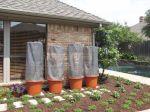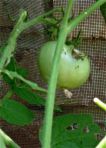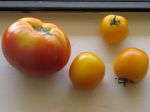I’ve been in the mood for intrigue and colorful personalities lately, and there is plenty of both to be found in the following books. Dan Fesperman was a new author for me and I’m going to read more of his work, and I want Tatjana Soli to write more soon! Her first novel, “The Lotus Eaters” was my favorite among this group. With wonderful weather, rain-fed flowers and new deck furniture for “feet up” reading,  I think I have found nirvana. I take absolutely no credit for any of these miracles; the hydrangeas this year are simply spectacular and all I have done is watch them bloom in wonder.
I think I have found nirvana. I take absolutely no credit for any of these miracles; the hydrangeas this year are simply spectacular and all I have done is watch them bloom in wonder.

 The tomato plants are already about to climb onto the roof!
The tomato plants are already about to climb onto the roof! 

OK, back to books. As usual, I have lifted these clips and reviews directly from Barnes & Noble or Amazon sites and none of the comments are mine. All I can tell you is that I enjoyed these, and they suited my reading mood.
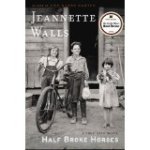 Half Broke Horses by Jeanette Walls
Half Broke Horses by Jeanette Walls
The New York Times Book Review – Liesl Schillinger
[Laura Ingalls] Wilder’s stories have acquired such mythic power…that it can be easy to forget how many American families shared similar histories, each with their own touchstones of calamity, endurance and hard-won reward. With convincing, unprettified narration, Walls weaves her own ancestor into this collective rough-and-tumble heritage.
The New York Times – Janet Maslin
…expertly rendered, gripping…The first thing that Ms. French does so well in Faithful Place is to inhabit fully a scrappy, shrewd, privately heartbroken middle-aged man. The second is to capture the Mackey family’s long-brewing resentments in a way that’s utterly realistic on many levels. Sibling rivalries, class conflicts, old grudges, adolescent flirtations and memories of childhood violence are all deftly embedded in this novel, as is the richly idiomatic Dublinese.
The Devil’s Footprints by John Burnside
“The best novels, while entertaining, offer the promise of teaching something crucial, ineffable about life and how to live it. We read them to survive. The Devil’s Footprints partakes of that quality…. Burnside is a luminous writer and a muscular thinker.”–Los Angeles Times
The Help by Kathleen Stockett
The Washington Post – Sybil Steinberg
Southern whites’ guilt for not expressing gratitude to the black maids who raised them threatens to become a familiar refrain. But don’t tell Kathryn Stockett because her first novel is a nuanced variation on the theme that strikes every note with authenticity. In a page-turner that brings new resonance to the moral issues involved, she spins a story of social awakening as seen from both sides of the American racial divide.
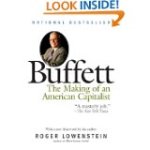 Buffett: The Making of an American Capitalist by Roger Lowenstein
Buffett: The Making of an American Capitalist by Roger Lowenstein
Amazon.com Review
Starting from scratch, simply by picking stocks and companies for investment, Warren Buffett amassed one of the epochal fortunes of the 20th century — an astounding net worth of $10 billion and counting. That awesome record has made him a cult figure.
This illuminating biography reveals a man whose conscientiousness, integrity, and good humor exist alongside an odd emotional isolation. Buffett also masterfully traces his life: his enormously successful partnership; his early, inspired investments in American Express and Geico; his companionship and investment with Katharine Graham of the Washington Post; his role in the Capital Cities purchase of ABC; his unique relationship with his wife and mistress; and his rescue of the scandal-ridden Salomon Brothers. –This text refers to the Hardcover edition.
 Layover in Dubai by Dan Fesperman
Layover in Dubai by Dan Fesperman
The Washington Post – Peter Earnest
Fesperman leads us on a lively chase as Keller plunges into a city of wildly differing, often clashing subcultures: traditional Arab society with its rigid social boundaries for women, the criminal underworld with its uneasy alliance between local gangs and the newly arrived Russian mafia, a police force steeped in politics and corruption, and even a rundown dormitory packed with overworked and underpaid foreign construction workers. With its fascinating insights about this Middle Eastern Miracle, Layover in Dubai whisks us from our workaday world into one far, far away.
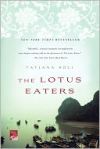 The Lotus Eaters by Tatjana Soli
The Lotus Eaters by Tatjana Soli
The New York Times – Janet Maslin
…quietly mesmerizing…Ms. Soli has done prodigious research about the Vietnam War, particularly about the role of female war photographers, and so is able to imbue an otherwise deeply romantic book with a strong sense of history.
The Amateur Spy by Dan Fesperman
The Washington Post – Patrick Anderson
The greatest strength of The Amateur Spy is this portrait of a world that most of us know almost nothing about. Fesperman shows persuasively the streets and the shops, the political factions and hatreds, the poverty and despair and sudden violence…As journalism, The Amateur Spy is exceptional.…My only problem with the novel was that I found some of its plot elements improbable—the scheme to blow up the political luminaries, for one—but Fesperman writes so well that it’s easy to follow wherever he leads. Besides, who is to say what’s improbable in an age of random terror?
 How to LIVE: A Search for Wisdom from Old People by Henry Alford
How to LIVE: A Search for Wisdom from Old People by Henry Alford
The Barnes & Noble Review
Though the work of a reviewer is certainly not to judge the book by its cover, in the case of How to Live: A Search for Wisdom from Old People (While They Are Still on This Earth), it is easy to get hung up on the adorable image of a wrinkly Shar-pei, a dog that only exhibits such rolls of flesh in puppyhood. Perhaps an indication of the contradictory nature of such a quest? Henry Alford, who penned two previous investigations rife with wry humor — Big Kiss: One Actor’s Desperate Attempt to Claw His Way to the Top and Municipal Bondage: One Man’s Anxiety-Producing Adventures in the Big City — injects his own brand of levity into the larger philosophical challenge of defining wisdom by delving into the experiences of elders. What he discovers is indeed contradictory at times but unexpected and life-altering, too. Like any journey of a thousand miles, he begins with the first step: compiling a list of aging icons to interview. While traveling between such disparate locales as Granny D’s humble abode in New Hampshire and the Hawaiian paradise of Ram Dass, Alford has plenty of time to contemplate another elder situation, the end of his mother’s 36-year marriage. Delving into Ecclesiastes and the words of Confucius, Buddha, and Socrates, and combing deathbed confessionals and famous quotations, Alford is guided through his own conflicting emotions about aging. Along the way his narrative, replete with laser-like observations and witty banter, is so thoroughly captivating that the answer to the title question becomes less important than the quest. It’s a profound revelation that comes through each person’s life story — which, we come to understand, is exactly the point. —Lydia Dishman






